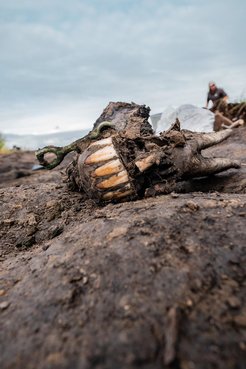Siberian Spectral Riders – A Top 10 Archaeological Discovery of 2024
An international study led by Gino Caspari of the Max Planck Institute of Geoanthropology traced the origins of the Scythian culture to Siberia, becoming one of Archaeology Magazine’s Top 10 Discoveries of 2024

Archaeologists excavating the 2,800-year-old Tunnug 1 burial mound in Tuva, southern Siberia, have uncovered striking evidence of human and horse sacrifices, shedding light on the origins of the Scythian culture. This discovery, published in the journal Antiquity in October 2024, provides a crucial link between the Scythians of Eastern Europe and their previously enigmatic eastern origins.
The Scythians of the Eurasian Steppe are renowned for their horse-centric lifestyle and intricate ‘animal-style’ art. While their presence in the Pontic Steppe of modern Ukraine and southwest Russia is well-documented, their cultural roots had remained elusive.
“The horseback-riding Scythians have captured imaginations since the time of Herodotus,” explains Dr. Gino Caspari, lead author from the Max Planck Institute of Geoanthropology and the University of Bern. “Our findings trace their cultural origins to the eastern steppes of Eurasia, revealing connections to early horse cultures in Mongolia.”

At Tunnug 1, one of the largest and earliest burial mounds in the Eurasian steppes, researchers discovered the fragmented remains of humans and horses, believed to have been sacrificed in honor of an elite individual. Accompanying these remains were Scythian-style artefacts and horse-riding equipment, marking this site as one of the earliest examples of Scythian funerary practices. The findings indicate that the origins of Scythian culture lie far to the east of their later heartlands in Eastern Europe. Parallels with Late Bronze Age burial practices in Mongolia further suggest that Scythian funerary traditions have deep roots in the horse cultures of Inner Asia.
“These discoveries highlight Tuva’s pivotal role in Eurasian prehistory,” Caspari adds. “They emphasize the importance of Inner Asia in fostering early transcontinental cultural connections and the role of funerary practices in shaping the political and cultural landscape of the Eurasian steppe.”













